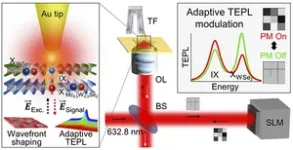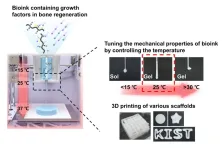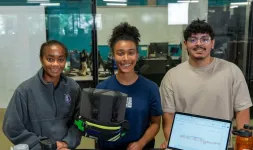Data can now be processed at the speed of light!
2023-04-14
(Press-News.org)
How can Marvel movie character Ant-Man produce such strong energy out of his small body? The secret lies in the “transistors” on his suit that amplify weak signals for processing. Transistors that amplify electrical signals in the conventional way lose heat energy and limit the speed of signal transfer, which degrades performance. What if it were possible to overcome such limitation and make a high-performance suit that is light and small but without loss of heat energy?
A POSTECH team of Professor Kyoung-Duck Park and Yeonjeong Koo from the Department of Physics and a team from ITMO University in Russia led by Professor Vasily Kravtsov jointly developed a “nano-excitonic transistor” using intralayer and interlayer excitons in heterostructure-based semiconductors, which addresses the limitations of existing transistors.
“Excitons” are responsible for light emission of semiconductor materials and are key to developing a next-generation light-emitting element with less heat generation and a light source for quantum information technology due to the free conversion between light and material in their electrically neutral states. There are two types of excitons in a semiconductor heterobilayer, which is a stack of two different semiconductor monolayers: the intralayer excitons with horizontal direction and the interlayer excitons with vertical direction.
Optical signals emitted by the two excitons have different lights, durations, and coherence times. This means that selective control of the two optical signals could enable the development of a two-bit exciton transistor. However, it was challenging to control intra- and interlayer excitons in nano-scale spaces due to the non-homogeneity of semiconductor heterostructures and low luminous efficiency of interlayer excitons in addition to the diffraction limit of light.
The team in its previous research had proposed technology for controlling excitons in nano-level spaces by pressing semiconductor materials with a nano-scale tip. This time, for the first time ever, the researchers were able to remotely control the density and luminance efficiency of excitons based on polarized light on the tip without directly touching the excitons. The most significant advantage of this method, which combines a photonic nanocavity and a spatial light modulator, is that it can reversibly control excitons, minimizing physical damage to the semiconductor material. Also, the nano-excitonic transistor that utilizes “light” can help process massive amounts of data at the speed of light while minimizing heat energy loss.
Artificial intelligence (AI) has made inroads into our lives more quickly than we ever expected, and it requires huge volumes of data for learning in order to provide good answers that are actually helpful for users. The ever-increasing volume of information should be collected and processed as more and more fields utilize AI. This research is expected to propose a new data processing strategy befitting an era of data explosion. Yeonjeong Koo, one of the co-first authors of the research paper, said, “The nano-excitonic transistor is expected to play an integral role in realizing an optical computer, which will help process the huge amounts of data driven by AI technology.
The research, recently published in international journal ACS Nano, was supported by the Samsung Science and Technology Foundation and National Research Foundation of Korea.
END
ELSE PRESS RELEASES FROM THIS DATE:
2023-04-14
PITTSBURGH, April 13, 2023 – In a paper published today in Molecular Psychiatry, a team of scientists from the University of Pittsburgh in collaboration with researchers in Italy described shared patterns of sleep disturbances and irregularities in daily rhythms of rest and activity across patients with schizophrenia spectrum disorder, or SSD.
By using wrist monitors that measured activity and rest as proxies of wakefulness and sleep, researchers found that individuals with SSD who resided in psychiatric hospitals and those who manage their condition in outpatient settings had erratic sleep patterns, dysregulated transitions between sleep ...
2023-04-14
A stop smoking mobile app that senses where and when you might be triggered to light up could help people quit – according to University of East Anglia research.
Quit Sense is the world’s first Artificial Intelligence (AI) stop smoking app which detects when people are entering a location they used to smoke in. It then provides support to help manage people’s specific smoking triggers in that location.
Funding for the Quit Sense app has come from the National Institute for Health and Care Research (NIHR) and the Medical Research Council.
A study published today shows how the new ...
2023-04-14
A University of South Australia nursing lecturer has used her own COVID-19 experience to inform research into a little-known side effect of the virus – sudden deafness.
Kim Gibson, a registered nurse with a clinical background in neonatal intensive care, has documented her experience with sudden sensorineural hearing loss (SSNHL) five weeks after testing positive to COVID-19. She was fully vaccinated.
Her findings and recommendations are published in the latest edition of the British Medical Journal Case Reports.
Gibson developed acute hearing loss in one ear, along with ...
2023-04-14
SINGAPORE, 14 April 2023 – A preclinical study using stem cells to produce progenitor photoreceptor cells—light-detecting cells found in the eye—and then transplanting these into experimental models of damaged retinas has resulted in significant vision recovery. This finding, by scientists at Duke-NUS Medical School, the Singapore Eye Research Institute and the Karolinska Institute in Sweden, marks a first step towards potentially restoring vision in eye diseases characterised by photoreceptor loss.
“Our laboratory has developed a novel method that enables the production of photoreceptor ...
2023-04-14
In celebration of World Quantum Day (14th April), IOP Publishing (IOPP) is launching a special collection of its most popular, cutting-edge quantum research published in the last two years.
The IOPP quantum collection is openly available for anyone to read and showcases world-class quantum research published in the academic journals Materials for Quantum Technology, Quantum Science and Technology, New Journal of Physics and Reports on Progress in Physics. The special collection will also include unique perspectives from women in quantum and their contributions to this popular field.
Quantum research and technology is evolving ...
2023-04-14
Tokyo – April 13, 2023 – Toppan (TYO: 7911), a global leader in communication, security, packaging, décor materials, and electronics solutions, and Hokkaido University have launched the “Comprehensive Dementia Research Unit,” an industry creation section that will collaborate with the Hokkaido University Collaborative Project Center’s Cognitive Science Research Center, which conducts comprehensive research on diagnosis technologies for dementia.
Fusing Toppan’s Digital ICA™1 technology for high-sensitivity ...
2023-04-14
The development of biomaterials for artificial organs and tissues is active due to an increase in accidental injuries and chronic diseases, along with the entry into a super-aged society. 3D bioprinting technology, which uses cells and biomaterials to create three-dimensional artificial tissue structures, has recently gained popularity. However, commonly used hydrogel-based bioinks can cause cytotoxicity due to the chemical crosslinking agent and ultraviolet light that connect the molecular structure of photocuring 3D-printed bioink.
Dr. Song Soo-chang's research team at ...
2023-04-14
To find a fast, efficient way to clear harmful chemicals along the Gulf of Mexico coastline, researchers are turning to something already familiar with the task – several species of the aquatic grasses and rice that feel very much at home in murky coastal waters.
The research team led by University of Houston’s Venkatesh Balan, associate professor of biotechnology in the Cullen College of Engineering’s Division of Technology, studies the abilities of these water-loving flora to uptake concentrations ...
2023-04-13
HOUSTON – (April 13, 2023) – Body image can have a significant impact on a person’s life, especially in their youth.
For those suffering from rib flaring associated with congenital deformations of the chest wall that cause it to jut out or cave in, a team of Rice University engineering students has come up with a potential solution.
Pectus carinatum and pectus excavatum are conditions in which a person is born with their breastbone protruding outward or sunken inward, respectively. There ...
2023-04-13
Public and private organizations around the world are developing fusion energy devices that could serve as models for fusion power plants. Scientists are striving to duplicate the fusion power that drives the sun and stars as a source of carbon-free energy to generate electricity without contributing to climate change.
While fusion plants could help meet global energy demands without emitting greenhouse gases and producing long-lived radioactive waste, they could also have risks — many of which were discussed at a two-day workshop hosted by the U.S. Department of Energy’s (DOE) Princeton Plasma Physics Laboratory ...
LAST 30 PRESS RELEASES:
[Press-News.org] Data can now be processed at the speed of light!









